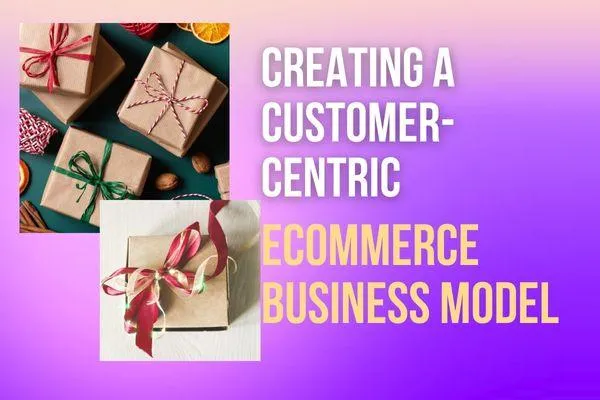E Commerce Blog: Cut Through The Noise & Focus On What Works

Creating A Customer-Centric Ecommerce Business Model
In the rapidly evolving world of ecommerce, businesses must adapt to meet the ever-changing needs of their customers. One of the most effective ways to achieve this is by creating a customer-centric ecommerce business model. This approach prioritises customer experience and satisfaction, ensuring that every decision made is rooted in the needs and preferences of your audience. For product-based entrepreneurs, embracing a customer-centric strategy can significantly enhance business growth and customer loyalty.
Understanding The Customer - centric Model
A customer-centric ecommerce business model focuses on understanding and responding to customer needs at every touchpoint. This means placing the customer at the heart of your business decisions, from product development to marketing strategies. The benefits of a customer-centric approach include:
Enhanced Customer Experience: By actively listening to customers and responding to their feedback, businesses can create a more enjoyable shopping experience.
Increased Loyalty: When customers feel valued and understood, they are more likely to return and recommend the brand to others.
Improved Sales: Satisfied customers are often repeat customers, leading to increased revenue and long-term success.
The NatZen Story: A Real-Story
Let’s take inspiration from NatZen, a skincare brand created by me, as a new mompreneur. At the heart of NatZen's success is a commitment to a customer-centric model. I've realised early on that my customers were not just looking for products; they wanted an experience that resonated with their values and lifestyle.
To create this experience, I focused on the following strategies:
1. Understanding Customer Needs: I have invested a significant amount of time in gathering feedback from my customers. I conducted surveys and engaged with them on social media, asking questions like, "What challenges do you face when shopping online?" and "What products would make your life easier?"
2. Personalising the Shopping Experience: Using the insights I gained, we then tailored NatZen's product offerings and marketing messages. For example, she introduced a subscription service for busy mothers who appreciated the convenience of having essentials delivered regularly.
3. Simplifying the Checkout Process: At NatZen we recognised that a complicated checkout process could lead to cart abandonment. We streamlined ours by reducing the number of steps required to complete a purchase and offering multiple payment options, making it easier for our customers to buy what they wanted.
There are paid Tools and Apps that can make the Checkout Process even more simple, such as One Page Checkout for Woocommerce and Shopify.
4. Building Trust and Credibility: To enhance customer confidence, we have showcased customer reviews and testimonials prominently on NatZen's website. I also offered a money-back guarantee, reassuring potential buyers that they could shop with peace of mind.
To enhance credibility, consider using Stamped.io, which allows you to collect and showcase customer reviews on your website. Positive feedback from satisfied customers can significantly influence potential buyers and reinforce your brand’s reputation.
Here is the example of One Page for all the testimonials NatZen has historically collected through Stamped.

Key Components of a Customer-Centric Ecommerce Model
Creating a customer-centric ecommerce business model involves several key components:
1. Collecting and Analysing Customer Feedback
Understanding customer needs is crucial. Regularly collect feedback through surveys, reviews, and social media interactions. By analysing this data, you can identify trends and areas for improvement. Asking questions like, "What do you love about our products?" and "How can we serve you better?" can provide invaluable insights.
2. Personalising Customer Interactions
Using customer data to personalise marketing efforts can significantly enhance customer experience. This could involve sending tailored email campaigns based on previous purchases or providing product recommendations that align with their interests.
Using an all-in-one email marketing platform like Mailerlite can help you grow your email list and create personalised campaigns that resonate with your customers. By sending tailored offers and updates, you can enhance the shopping experience and foster loyalty
3. Fostering a Customer-Centric Culture
Training your team to adopt a customer-centric mindset is essential for ensuring that every member of your organisation prioritises customer satisfaction. Encourage employees to take ownership of customer interactions and to seek ways to improve the overall experience.
4. Utilising Technology for Better Insights
Investing in technology can help you gather and analyse customer data more effectively. Implementing Customer Relationship Management (CRM) systems or analytics tools can provide deeper insights into customer behaviour and preferences.
5. Ensuring Accessibility and Convenience
Make it easy for customers to reach you and find the information they need. A user-friendly website design and responsive customer service can make a significant difference in how customers perceive your brand.
The Benefits of a Customer-Centric Ecommerce Strategy
Implementing a customer-centric approach can lead to numerous benefits for your ecommerce business:
Higher Customer Retention Rates: Happy customers are more likely to return, reducing the need for extensive marketing efforts to attract new ones.
Increased Sales: A positive shopping experience often results in increased spending, as satisfied customers are inclined to purchase more.
Enhanced Brand Reputation: Building a brand that prioritises customer satisfaction can lead to positive reviews and word-of-mouth referrals.
Answering Common Questions
As you embark on creating a customer-centric ecommerce business model, you may find yourself asking:
1. What is a customer-centric ecommerce business model?
It’s a business approach that prioritises understanding and responding to customer needs, ensuring their experience is at the forefront of all operations.
2. How can I implement a customer-centric strategy in my ecommerce store?
Start by collecting customer feedback, personalising interactions, and training your team to focus on customer satisfaction.
3. What are the benefits of prioritising customer experience in ecommerce?
A customer-centric approach can lead to enhanced customer loyalty, increased sales, and improved brand reputation.
4. How can understanding customer needs improve my ecommerce business?
By knowing what your customers want, you can tailor your offerings and marketing strategies to better meet their expectations.
5. What tactics can I use to enhance customer loyalty online?
Personalisation, providing excellent customer service, and creating a seamless shopping experience can help build loyalty.
Conclusion
Creating a customer-centric ecommerce business model is not just beneficial; it is essential for long-term success. By prioritising customer needs and preferences, you can foster loyalty and drive sales. Take inspiration from Ella’s journey with NatZen and start implementing these strategies today.
If you’re eager to learn more about boosting your ecommerce sales and building lasting customer relationships, be sure to check out our Double Your Sales Guide. This resource is designed to provide you with actionable strategies to help elevate your business to new heights.
15 Days Boost Your Email List Growth Challenge
Join our fun, easy to implement exclusive "15-Days To Grow Your Email List Challenge and unlock the secrets to expanding your customer base! Whether you're juggling kids, work projects, side hustles this challenge is designed to fit into your hectic life, giving you actionable steps to sky-rocket your email list and drive sales.

PRIVACY POLICY | TERMS OF USE | FAQ | SITEMAP
© Copyrights by Soul Led Ecommerce. All Rights Reserved.
Website optimised by pomegranate.marketing


